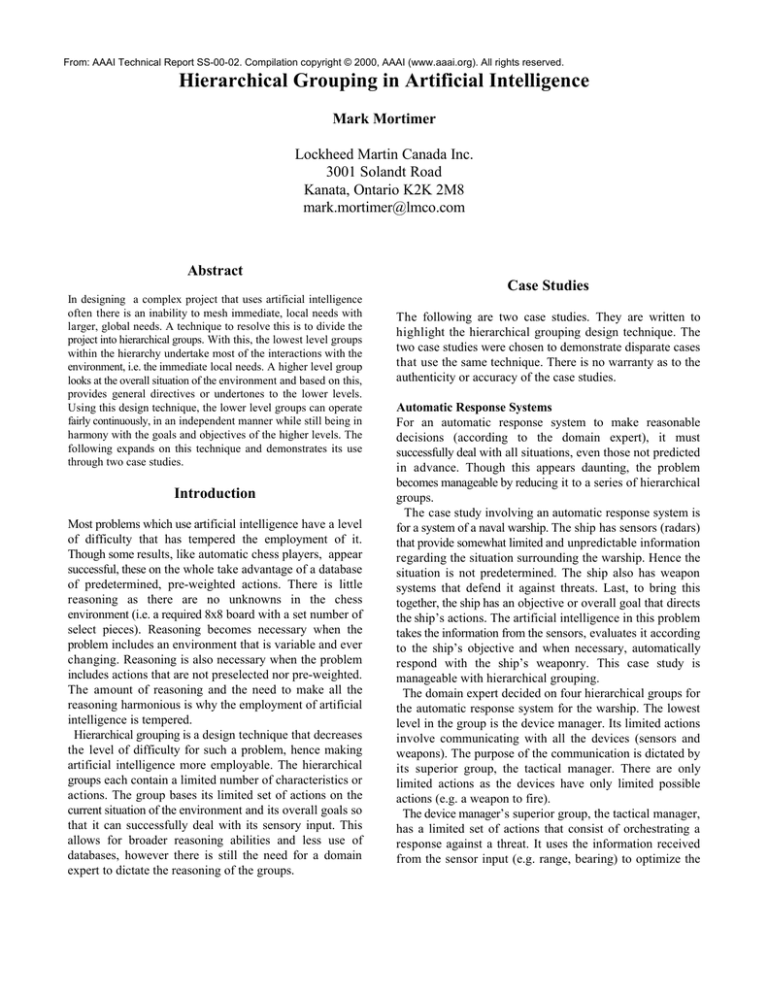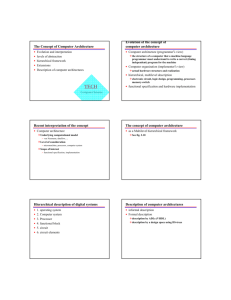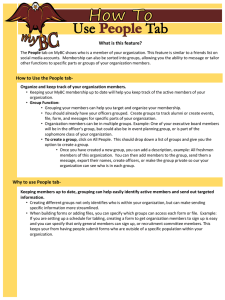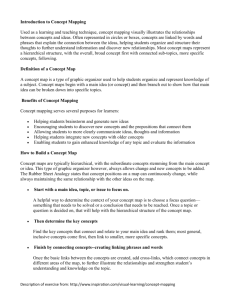
From: AAAI Technical Report SS-00-02. Compilation copyright © 2000, AAAI (www.aaai.org). All rights reserved.
Hierarchical Grouping in Artificial Intelligence
Mark Mortimer
Lockheed Martin Canada Inc.
3001 Solandt Road
Kanata, Ontario K2K 2M8
mark.mortimer@lmco.com
Abstract
Case Studies
In designing a complex project that uses artificial intelligence
often there is an inability to mesh immediate, local needs with
larger, global needs. A technique to resolve this is to divide the
project into hierarchical groups. With this, the lowest level groups
within the hierarchy undertake most of the interactions with the
environment, i.e. the immediate local needs. A higher level group
looks at the overall situation of the environment and based on this,
provides general directives or undertones to the lower levels.
Using this design technique, the lower level groups can operate
fairly continuously, in an independent manner while still being in
harmony with the goals and objectives of the higher levels. The
following expands on this technique and demonstrates its use
through two case studies.
Introduction
Most problems which use artificial intelligence have a level
of difficulty that has tempered the employment of it.
Though some results, like automatic chess players, appear
successful, these on the whole take advantage of a database
of predetermined, pre-weighted actions. There is little
reasoning as there are no unknowns in the chess
environment (i.e. a required 8x8 board with a set number of
select pieces). Reasoning becomes necessary when the
problem includes an environment that is variable and ever
changing. Reasoning is also necessary when the problem
includes actions that are not preselected nor pre-weighted.
The amount of reasoning and the need to make all the
reasoning harmonious is why the employment of artificial
intelligence is tempered.
Hierarchical grouping is a design technique that decreases
the level of difficulty for such a problem, hence making
artificial intelligence more employable. The hierarchical
groups each contain a limited number of characteristics or
actions. The group bases its limited set of actions on the
current situation of the environment and its overall goals so
that it can successfully deal with its sensory input. This
allows for broader reasoning abilities and less use of
databases, however there is still the need for a domain
expert to dictate the reasoning of the groups.
The following are two case studies. They are written to
highlight the hierarchical grouping design technique. The
two case studies were chosen to demonstrate disparate cases
that use the same technique. There is no warranty as to the
authenticity or accuracy of the case studies.
Automatic Response Systems
For an automatic response system to make reasonable
decisions (according to the domain expert), it must
successfully deal with all situations, even those not predicted
in advance. Though this appears daunting, the problem
becomes manageable by reducing it to a series of hierarchical
groups.
The case study involving an automatic response system is
for a system of a naval warship. The ship has sensors (radars)
that provide somewhat limited and unpredictable information
regarding the situation surrounding the warship. Hence the
situation is not predetermined. The ship also has weapon
systems that defend it against threats. Last, to bring this
together, the ship has an objective or overall goal that directs
the ship’s actions. The artificial intelligence in this problem
takes the information from the sensors, evaluates it according
to the ship’s objective and when necessary, automatically
respond with the ship’s weaponry. This case study is
manageable with hierarchical grouping.
The domain expert decided on four hierarchical groups for
the automatic response system for the warship. The lowest
level in the group is the device manager. Its limited actions
involve communicating with all the devices (sensors and
weapons). The purpose of the communication is dictated by
its superior group, the tactical manager. There are only
limited actions as the devices have only limited possible
actions (e.g. a weapon to fire).
The device manager’s superior group, the tactical manager,
has a limited set of actions that consist of orchestrating a
response against a threat. It uses the information received
from the sensor input (e.g. range, bearing) to optimize the
weaponry usage. Optimization includes setting the start
time, possible repetition time and the end time or condition.
The tactical manager uses its predefined knowledge of the
weaponry also to estimate the threat’s response. If the
threat’s measured response is not as predicted, then the
tactical manager will cease use of the weapon and notify its
superior of the failure. Its superior is the engagement
manager.
The goal of the engagement manager’s limited set of
actions is to defeat a threat. The engagement manager uses
the sensor’s information regarding a threat and, based
somewhat on a predetermined database, will allocate
necessary weaponry to defeat the threat. The engagement
manager can set up a series of possibly multiple weaponry
actions that provide the greatest overall likelihood of
defeating the threat. Also, if the tactical manager informs
the engagement manager that a given tactic is not working,
then the engagement manager can create a new series of
multiple weaponry actions that do not include the failed
weapon. The engagement manager will constantly have
knowledge of the progress it has made in defeating the
threat. This state of this progress is used by the engagement
manager’s superior, the battle manager.
The goal of the battle manager’s limited set of actions is
to assess the combat scenario and coordinate simultaneous
engagements in order to achieve the ship’s overall goal or
objective. As there are multiple types and instances of
weaponry onboard a warship, the battle manager must
prevent overkill or underkill. It must also coordinate the
weaponry in the engagement so that the use of one weapon
does not adversely affect the use of another. In addition, the
battle manager examines the combat scenario to ensure that
its actions do not unduly affect other friendly forces. For
example, a ship would not want to shoot a chaff round close
to another friendly naval vessel (as a decoyed threat would
then hit the other friendly vessel). The undertone for all the
battle manager’s decision however is its need to achieve the
ship’s overall goal.
The ship’s overall goal is variable and can change with
time. It may have a goal of self-survival, coastal
bombardment, and / or convoy escort. However, the battle
manager uses this goal to provide any directives to its
immediate inferior, the engagement manager. For example,
the battle manager may have reasoning that indicates that
self-destruction is better than losing a (higher valued)
convoy member hence, this undertone, a result of the ship’s
overall goal, would be part of the battle manager.
By using these four levels of hierarchal grouping, we have
successfully divided a complex automatic response system
problem into manageable groups. Further, due to the
communication between the groups, the high level group
that assesses the ship’s overall goal provides undertones to
inferior groups so that low level actions are influenced by
the higher levels. For the system as a whole, the weapon
usage is optimized and includes the strategic directives of the
ship.
Guiding a Collection of Units
The second case study using hierarchical grouping is for
guiding a collection of units. The challenge in guiding such
a collection is the need to trade off the goals of the individual
unit against the goals of the collection. The particular case
study for demonstrating this technique for guiding units is for
a military unit within a collection of military units, i.e. a
military simulation. Remember that this case study is meant
to illustrate a coding technique and the subject is not
necessarily authentic or accurate.
In a traditional military simulation or wargame there are
collections of units that act based on; the current situation,
how the current situation arose, how its actions may affect the
situation and how other’s actions may affect the situation. In
a typical wargame, there are many units of diverse types that
move within a complex, variable environment. A unit solely
choosing an action from a database suffers from an inability
to adapt to unique situations. However, using hierarchical
groups, the units in a wargame can have artificial intelligence
that supplies valid directives for all environments, hence
making all actions reasonable.
For a unit’s actions to be reasonable, the decision that it
takes must have an objective or goal. In the previous case
study, the ship’s objective or goal was the undertone for the
decision making. In much the same manner, a military unit
must have an undertone. This undertone should not prevent
the unit from operating independently, however, it should
influence the units decision. The following illustrates
hierarchical groupings that carry the undertone to all groups.
The lowest hierarchical level in the military wargame is
responsible for doing the actions (much as the device
manager did in the previous case study). This lowest level
could simulate a soldier, a platoon, or a company. This
lowest level has a limited number of actions it can perform.
Though it has some of its own reasoning, it also receives
direction from its superior group. If the lowest level were a
soldier, then the soldier would consider its immediate
situation, prior actions and postulated activities.
Considerations include the presence of enemy soldiers,
daylight hours, and / or the amount of remaining
ammunition. It then acts based on the immediate situation
while also considering the undertone provided by its superior
level
The superior level is a construct used by the artificial
intelligence. It is not an entity and can not perform any
physical actions that affect the environment. Its purpose is to
provide directives that affect its own immediately subordinate
level. For example, consider a simulated platoon. The platoon
is a collection of soldiers. The platoon does not fight as it
does not have any physical capability. Rather, it guides its
collection of soldiers to achieve a goal that (presumably) one
soldier would not be able to achieve on its own. The platoon
would assess the situation in its sphere of influence and
inform or direct its soldier to achieve a certain goal or
objective; for instance, attack in a general given direction
or capture a house.
It is then the responsibility of the soldier to take this
information or directive and use it to guide its actions. The
soldier may not instantly follow the directive (eg first
resolving an ongoing fire-fight) or the soldier may have a
preferential task immediately at hand (eg disarming a group
of prisoners). However, the soldier would have a set of
decision making parameters (aka threshold level units) that
would dictate when it is to follow its own directives or when
it is to follow the information passed down from its superior
or when it follows some combination of each.
This design technique using hierarchical grouping does
not have a limit in the depth of groups. The above example
is for soldiers and a platoon. There could be many platoons
that are grouped into a company, the companies are
grouped into battalions, then brigades, and so on. The
construct resembles a typical tree structure with a root node
or group (the highest level) and connecting branches to
lower levels or inferior nodes or groups.
Further, there is no limit to the breadth of the groups
(aside from computer hardware limits). There can be as
many soldiers, platoons and companies as necessary. The
number and size of the groupings are typically resolved in
scenario test phases.
Thus with the design technique of hierarchical grouping,
there is an efficient technique that resolves the complex
problem of directing a unit within a collection of units. By
dividing the decision making into hierarchical groups or
levels, the war game simulation becomes manageable. The
lowest group of the simulation is the group that does actions
and affects the world about it. The higher levels are able to
obtain more information about the situation for a wider
field. They then provide the information as directives or
undertones that the lower levels consider but not necessary
immediately completely adhere to.
Constraining Communications
A beneficial consequence of using hierarchical grouping is
that there is limited communication between the groups.
The only communication is between an inferior and its own
superior. Further, this communication is constrained to be
the superior influencing the objective or goal for the
inferior level by inserting undertones. The inferior level is
constrained by providing the status of its progress in
achieving an objective or goal. This is typical of a military
‘chain of command’ limited communication.
Ease in Programming
The above description of the hierarchical grouping design
technique is purposefully written to display the design
technique’s similarity to designing object oriented programs.
By interchanging the word ‘group’ in much of the preceding
with the word ‘class’, many features of object oriented
programming are evident. For example on replacement we
see classes and sub-classes with constrained communication.
Each class has a limited set of actions. Each class has its own
view of the situation and its own functions on what to do as
based on its view. This is similar to discussions in many texts
on object oriented programming.
For the military simulation case study, both C and C++
computer language constructs are used. This is due to the
evolution of the code rather than any foresight. The groups
are coded as classes. There is constrained communication
between the classes. However, rather than soldiers being the
lowest level, the lowest level is a corp. The next superior
level(or group) is the army and the final superior or root level
is the theatre group.
For the automated response system, the groups are coded as
knowledge sources in an expert system environment. The
knowledge sources are data driven, where effectively, all the
data of the situation is situated on a blackboard. Because of
many benefits of using an expert system with a blackboard,
standard object oriented programming was not used.
Other Applications
The design technique of hierarchical grouping is applicable
to many artificial intelligence areas. The case study of having
a unit in a collection of units is purposefully vague. The unit
can be a character in a role playing game, it can be a bee in
a colony, or even a staff member of a typical business.
Another application of hierarchical grouping is in varying
the amount of independence of sub-groups. For example,
varying the independence in a military simulation makes the
simulation representative of various societies. Sub-groups that
allow a high degree of independence can be construed to
resemble typical western forces in the historical red star/white
star scenarios. Eastern forces would have sub-groups with
much less independence and would thus have most of the
decision making occurring at the root node. By running
simulations using various degrees of independence in subgroups, resulting effects can be observed.
At present, the analysis with the military simulation case
study is looking at fixing the necessary and sufficient limited
actions for each group. Once reasonable actions are achieved,
then the effects of varying the degree of independence will be
studied.
There can also be some communication for sub-groups
within the same group. For instance, soldiers can
communicate with soldiers of their own platoon, their platoon
communicates with its fellow platoon members of their
company, and so on. This intra-group communication is
possible throughout the depth of the hierarchy.
Conclusion
With hierarchical grouping, a complex project can have
reasonable artificial intelligence. Hierarchical grouping has
a low level that does the interactions with the environment.
Possible interactions consist of initiating automatic
response systems or moving individual units within a
collection. Superior levels add undertones to lower levels’
interactions. The undertones are based on the superior
level’s larger view of the situation. The undertone will
influence the lower level without dictating the lower level
decision making. There is no limit to the number of levels
or depth of grouping nor in the breadth or number of
elements within a group. Thus, through hierarchical
grouping, there is a design technique for complex projects
that provides reasonable artificial intelligence.






